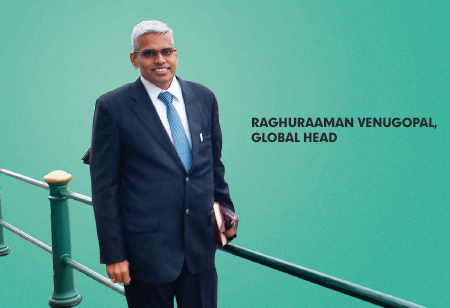The Role Of HR as a Strategic Business Partner
By Raghuraaman Venugopal, Global Head - ODC - HR Syntel

Raghuraaman Venugopal, Global Head - ODC - HR Syntel
Syntel is a leading global provider of integrated information technology and knowledge process services.
Over the last few decades, the dichotomy of man and machine has been tested, and every era brings a growth and refinement in technology. Whether it is the agro economy or the new era of information technology, productivity. ROI is the key factorby which we measure growth. With the advent of digital technology, frugal innovation has significantly impacted this equation, and effective talent management is essential.
As information technology evolves, this man vs. machine conflict has grown equally sophisticated. In earlier times, employees had to travel to a work location in order to deliver. Now, work can be brought to the workers through technological innovation. Let’s look at how technology has affected this dynamic, and some trends to watch out for in the future.
Technology is Replacing Talent Mobility
Google, with headcount of 72,000+ resources and a valuation of $370 billion,has been successful in moving work to people across the globe. We only see signs of this trend continuing to accelerate, driven by new technology advances.
Traditional Hiring Models will Undergo a Sea Change
Cost effective models will replace people dependencies, becoming more process driven to ensure business continuity across borders. Every country today is sensitive to employment issues, solocal hiring will become more prevalent.
In the traditional model, it takes an average of 45–60 days to fill a vacant position from the market.The average tenure of millennial workers is about 18-24 months before they move on to the next potential employer. Traditional models must adapt to stabilize these gaps and retain top talent.
New-age Talent Mobility Practices will become the Norm
Gig workers and crowd sourcing are becoming more prominent, and Bots will soon becom epart of the payroll. Talent will be confined to specialty jobs and the “Uberisation” of talent will continue. Specialty talent will be deployed to navigate organizations through changes in the underlying business model, and regular transactional work will be shifted more and more towards automated support. Of course, social platforms will be the major source of skill referrals.
Automation will Enhance Productivity by Reducing Individual Dependencies
A LEAN management approach focuses on error prevention and self-cure, instead of simply detecting errors. The talent pool for specialist jobs will grow and automate, adding more to the knowledge legacy. One example of this is how Amazon overcame a huge challenge in delivery.
As a process, each item in their store were supposed to be picked up manually from shelves and to be quickly placed on a conveyer belt to collect and route the items to their destination. Amazon had 50,000 people performing this task alone in their warehouses. When the same task was replaced with a Berlin Robot, it was able to multitask successfully, and there are now 15,000 robots already engaged.
Conclusion
Globalization 1.0saw innovations in rail roads and oceangoing vessels that reshaped the way goods and services were delivered. After World War One, peace efforts everywhere prepared society for Globalization 2.0, with more sophisticated supply chains built with information and technology.
Now we are again at a cross roads,as borders blur through advancements like Frugal Engineering design and virtual medical screening. Apps can now remotely offer legal and financial consulting, and disruptive technologies have paved the way for innovations in the knowledge economy, cloud computing, advanced robotics, AI, energy storage and genomics.
As the next wave of globalization emerges, HR professionals must embrace technology to ensure that they can keep pace with new business models and a more focused and technologically sophisticated workforce.




